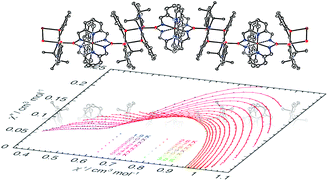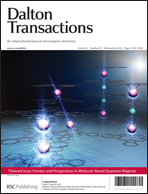Observation of two types of magnetization relaxation in a weakly correlated antiferromagnetic chain of MnIII2 single-molecule magnets†
Abstract
A MnIII2FeII chain with a [–MnIII–(OPh)2–MnIII–ON–FeII–NO–] repeat unit was synthesized via the assembling reaction of MnIII salen-type dimers and FeII pyridyloximate complexes, where the –(OPh)– and –ON– bridges represent a biphenolate bridge and an oximate bridge, respectively. The bulky counter anions, BPh4−, which surround the chain to form a

- This article is part of the themed collection: Frontier and Perspectives in Molecule-Based Quantum Magnet

 Please wait while we load your content...
Please wait while we load your content...